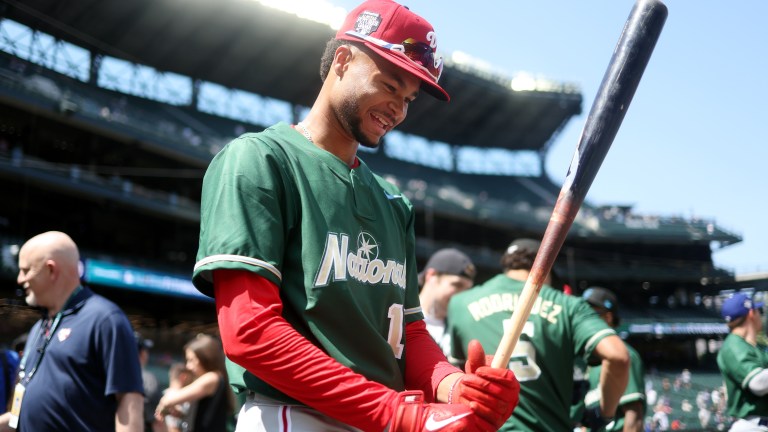Prospects Who Just Missed the Top 100
Not every top prospect in baseball could make our latest update of the top 100 released this week. Here's a look into 10 notable omissions.

We just released our updated top 100 prospect list, which included the 2024 draft class and as always, there’s quite a few top 100 worthy prospects who just missed making the cut.
Frankly, there’s easily another 50 or so prospects you could make a reasonable case are “top 100 worthy” and I wouldn’t bat an eye.
That’s the fun part about this whole thing, there’s a million ways to slice it and our goal is to at least provide the most detailed explanation to why things lined up the way they did for us.
With that said, let’s provide some context as to why some very qualified prospects just missed the cut. There were plenty more prospects who received serious consideration, however these were some of the names who were either the closest or we received the most responses on.
Caden Dana – RHP – Angels
How could I start with anyone else? There was no name brought up more in our replies, some kinder than others. Dana has been fantastic this season, pitching to a 2.75 ERA and has been even more impressive in the second half, so I get the appeal.
But it’s important to remember that we are projecting for the big leagues here and I have some concern that Dana’s arsenal looks to be more conducive to a back-end rotation spot than middle rotation upside.
He is just 20 years old and could grow into more stuff, though the brutal player development infrastructure he is forced to deal with curbs my optimism in that regard.
He has one pitch that flashes plus at this point, a mid 80s gyro slider that keeps both lefties and righties at bay. Beyond that, it’s nearly 60% fastball usage.
It’s a 93-95 mph fastball with decent characteristics that he has been able to succeed with because of his command and the fact that Southern League hitters have posted a .667 OPS this season.
He lacks a reliable third pitch, landing his curveball and changeup for a strike at a combined rate of roughly 45%. The execution of his heater and slider has been impressive, but I’m not sure there’s enough quality in those two offerings to consistently succeed as a two-pitch guy in the big leagues.
Moises Ballesteros – C/DH – Cubs
If not for Caden Dana, Ballesteros would have been the most mentioned prospect in our replies. He too, just missed. I got a chance to see Ballesteros make his Triple-A debut, where he put on an impressive offensive display both in batting practice and in game.
There’s no doubting he’s a natural hitter with above average power…but you’d be hard-pressed to find what he brings to the table beyond that.
I have some serious concern that he will not be able to stick behind the dish. As impressive as his offensive display was, his receiving and blocking was equally unimpressive.
Ballesteros has an above-average arm, but the transfers are too slow, resulting in him throwing out just 7-of-64 attempted base stealers (10%). Many are quick to point out the fact that Ballesteros is one of the youngest players in Triple-A and as encouraging as that is from an offensive perspective, it’s also a reminder that he may only become less mobile and athletic as he ages given his build.
If Ballesteros had a back up plan defensively, he probably still finds his way on the list, however at 5-foot-8, he would be the shortest first baseman in Major League Baseball which would only be half of the issue as he lacks the lateral quickness to be decent at the position.
While I think there’s enough offensive upside to be an above average hitter, the very real scenario that he ends up with no position requires him to provide elite production to project as an everyday big leaguer and even then, most teams don’t like their DH slot clogged.
Robert Calaz – OF – Rockies
I really wanted to put Calaz in there. The power upside is as tantalizing as any prospect at the lower levels and the production was ridiculous in the Arizona Complex League, I just couldn’t get passed the whiff rates.
Through 58 games between the Complex and Low-A, Calaz has run a contact rate of just 58%. Though powerful, his swing is quite stiff and rigid. He rarely missed mistakes, but he rarely hit well-executed pitches.
Still just 18 years old, it’s reasonable to hope that Calaz could find more rhythm and fluidity in his swing. It would take a pretty significant overhaul and at this point it really looks like he has one swing for one spot. He’s also a candidate to move off of center field.
Jackson Ferris – LHP – Dodgers
Ferris was a last minute omission and a player I expect to sneak into the end of season update. Acquired with Zyhir Hope in the Michael Busch trade, Ferris was a second round pick who received first round money to forego his college commitment.
Like many tall, young lefties, Ferris struggled with his command through his first professional season, walking 14% of batters.
In his second season as a pro and first season with the Dodgers, Ferris has trimmed the free passes to a 10% clip, particularly finding a consistent feel for his slider that flashes plus.
Ferris has shown a better feel for the fastball in individual starts, however it will come and go. He will mix in a curveball and changeup with little confidence, throwing more balls than strikes when he goes to them.
The stuff is good and the progress command wise is encouraging. That said, the stuff isn’t elite enough to palate the overall command inconsistencies at this stage, especially without a semi-reliable third offering.
Noble Meyer – RHP – Marlins
A year that started strong for Meyer hit a roadblock when he was promoted to High-A.
Still incredibly projectable, the 6-foot-5 righty won’t turn 20 years old until January. He gets good extension from a unique release that can be hard for hitters to pick up and hard for him to repeat.
He has struggled to a 58% strike rate this season, a number that has dwindled as the season has progressed, with far too many non-competitive pitches.
In addition to the command woes, Meyer’s velocity has slipped from 94 mph in his first 10 starts to just 92.5 mph over his last five outings, dipping towards 90 mph as he has gone deeper into starts.
It wouldn’t surprise me if the Marlins shut Meyer down a bit early this year and focus on getting him right for next season. He’s a talented prospect with plenty of upside.
Arjun Nimmala – SS – Blue Jays
This one hurt because I still really like him and think he can hit his way right back onto our top 100 list with some progress in the bat-to-ball department.
Nimmala has been far more productive since returning from the development list, producing a .957 OPS while launching nine home runs in just 31 games.
He’s still striking out at a 30% clip since returning and sells out for pull at this point with 42 of his 54 hits thus far being to the left of center field.
Nimmala has the tools to be a strong shortstop, but has looked a bit more raw than expected in the early going of his pro career. He has appeared more comfortable in the box each time I’ve checked in since he has returned from the development list, making him a strong candidate to grab a spot in the update if he can maintain his improvements.
Cooper Pratt – SS – Brewers
Pratt has been impressive as can be for a sixth round high school shortstop in his first pro season, albeit, he received second round money.
Standing at 6-foot-4, 195 pounds, Pratt is surprisingly a hit-over-power prospect at this stage, boasting a great feel for the barrel that has resulted in above average contact rates between Low-A and High-A in his age-19 season.
He has looked the part at shortstop as well, making all of the plays he needs to despite not possessing any particularly flashy tools.
The key for Pratt will be showing that he can tap into at least average power, and at this point, he is below average in that regard with an average exit velocity of 87.5 mph and a 90th percentile exit velocity of 100 mph.
There’s clearly room for Pratt to fill out and if he can tap into a bit more impact, his feel to hit and likelihood of sticking on the left side of the infield should make him a top 100 prospect at some point next season.
Justin Crawford – OF – Phillies
The son of MLB All-Star Carl Crawford, Justin is extremely talented as well, possessing 70 grade wheels and a strong glove in center field.
While has been productive as a pro, there’s too many red flags in the batted ball profile and swing mechanics.
It’s a long stroke that results in him catching the ball very deep, which makes it difficult to get the ball in the air, evident by his 63% ground ball rate and a negative launch angle on fastballs.
Crawford is very expansive as well, running a chase rate just below 40%. The results have been impressive as he puts the ball in play consistently and he has run a high BABIP thanks to his elite wheels, I just don’t think it’s sustainable against upper level pitching.
George Klassen – RHP – Angels
Acquired by the Angels in the Carlos Estevez trade, Klassen has been one of the most notable breakout arms in the Minor Leagues this year.
The stuff is loud, averaging 97 mph with his fastball, along with a pair of sharp breakers including a sharp cutterish slider at 90 mph and a power curve in the upper 80s.
A sixth round pick in the 2023 Draft, Klassen really struggled to throw strikes at the University of Minnesota before finding the zone much more frequently as a pro.
Klassen still is fringy in the command department and the maximum effort in his delivery lends concern that there may not be much more room for further improvement in that regard.
He has dominated the lower levels, overcoming his tendency to fall behind in counts with his fastball, something that could catch up to him more at the upper levels.
Klassen could continue to fend off the reliever risk, but until he turns lineups over at the upper levels, I’m going to be a bit skeptical about his chances of sticking as a starter.
Kevin Alcantara – OF – Cubs
A longtime fixture on the top 100 list, Alcantara is likely a victim of prospect fatigue to a degree as he has not particularly struggled at any stop. After getting plenty of live looks of Alcantara, I have become less confident in his bat.
He manages the whiff well for a 6-foot-6 long-levered hitter, maintaining his roughly 25% strike out rate at each level. Likely in an effort to be shorter to the ball, Alcantara’s swing path has become quite shallow, resulting in a ground ball rate of 55% and a launch angle below 5 degrees.
The gaudy exit velocities are exciting, but it is becoming less and less believable that he is going to be able to tap into it with any consistency in games. In 368 Minor League games, Alcantara has produced a .799 OPS.
He gets tied up pretty easily on hard stuff inside and the more shallow path has resulted in him frequently swinging over left-handed secondaries, of which he is hitting just .140 against this season.
Alcantara has cut his chase rate some, still sitting above 30%. He also has plus wheels that translate more in center field than the base paths (only 7 steals on 10 tries in 2024) where he looks to be an above average defender.
The defense in center helps elevate his floor and he is still just 22 years old, so it would be silly to completely count out “El Jaguar” from reaching his potential. I’m just becoming more skeptical.

